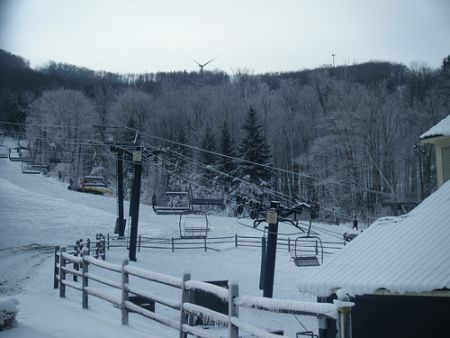
(Host) It’s not easy for the ski industry to be environmentally friendly. Resorts need lots of electricity to move people up mountains and millions of gallons of water to make snow.
But as energy costs rise, some resorts are reducing their carbon footprints.
As part of a collaboration with Northeast public radio stations, Susan Sharon of Maine Public Radio reports.
(Sharon) There’s nothing like the liberating feeling of gliding down a mountain. Skiers and snowboarders love the thrill, even if it means strapping on their skis at the bottom in the mud, getting on a windy chairlift and being confined to ski at the mountain’s summit.
(Baum) "It’s either that or stay at home."
(Sharon) David Baum of Wellesley, Massachusetts, was skiing with his family at the Sunday River Ski Resort in Newry, Maine, in late November. He wasn’t dissuaded by the lack of snow.
"No way. There’s snow up there."
(Sharon) Sunday River was one of just a few ski areas in the Northeast able to offer skiing that month. But for the first time in 20 years, just the top of the mountain was open. At the bottom it was raining.
Bill Brown was trying to look on the bright side. Brown is in charge of snowmaking and energy management on the mountain.
(Brown) "It’s frustrating. Is it really stressful? After you’ve done it for 21 years you kind of go: We’ll it’s going to get cold at some point and we’re going to go."
(Sharon) Brown was right. Since then Mother Nature has cooperated and blanketed Sunday River with snow. According to a recent report from the group Clean air-Cool Planet, the Northeast has seen warmer temperatures, fewer days with snow cover and decreased snowfall in recent decades. Ski resorts can make snow if it’s cold enough. But it takes lots of water and plenty of energy to power snowmaking equipment and chairlifts to carry skiers up the mountain. All this comes with a price, both environmental and economic.
(Strickler) "Energy bills were just getting out of control. Once our electric bill hit over $1 million a year we said something has got to give."
(Sharon) Betsy Strickler is the marketing director at Jiminy Peak in Western Massachusetts. It’s the first ski resort in North America to install an on-site wind turbine.
This is the sound of Jiminy’s snow guns converting water into snow using energy from the 1.5 megawatt wind turbine. It cost Jiminy’s owners about $3.5 million to make the investment. And Strickler says it’s already paying off.
(Strickler) "It’s about half of our snowmaking and it powers about a third of the chairlifts that we operate and then the central core of our hotel, including our restaurant. And it powers 100 percent of the Mountain Adventure Park in the summer, assuming the wind is blowing."
(Sharon) Bolton Valley in Vermont recently erected a smaller turbine. And around the northeast, large and small ski resorts are switching to more energy efficient snow-making equipment to save money.
At Sunday River electricity consumption has been cut 20 percent even as the mountain has expanded over the last 15 years. Bill Brown says conservation measures were adopted out of necessity.
(Brown) "I guess climate change is kind of always at the back of your mind, but it was economics."
(Sharon) Shawnee Peak in Bridgton, Maine, has also installed variable speed drives on its water pumps to save water and switched from diesel to natural gas, cutting 30 % of its energy costs in just a couple of years. But whether greener skiing can be an effective marketing tool remains to be seen. Some skiers are still grappling for a definition.
(Strickler) "I would presume no snowmaking, no grooming and you hike the mountain yourself?"
Not yet you don’t.
Back at Jiminy Peak Betsy Strickler says customers appreciate the mountain’s green makeover once they learn about it. But the further skiers drive to get to their favorite ski slopes, the more pollution they’re emitting to the environment. That’s why some ski areas have been promoting carpooling or mass transit, and why Shawnee Peak in Bridgton offers prime parking spaces to skiers who arrive in hybrid vehicles.
For VPR News, I’m Susan Sharon
(Host outro) Northeast environmental coverage is part of NPR’s Local News Initiative. The reporting is made possible, in part, by a grant from United Technologies.